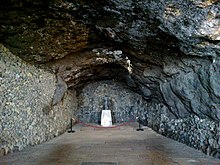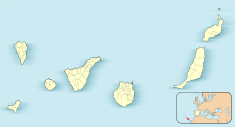Cueva de Achbinico
| Achbinico cave or Saint Blas cave |
|
|---|---|
|
Native name Spanish: Cueva de Achbinico / Cuevo de San Blas |
|
 |
|
| Location | Candelaria, Tenerife, Canary Islands, Spain |
| Coordinates | 28°21′03″N 16°22′10″W / 28.3508°N 16.3695°WCoordinates: 28°21′03″N 16°22′10″W / 28.3508°N 16.3695°W |
| Official name: Cave of Achbinico | |
| Criteria | Monument |
| Achbinico cave and chapel or San Blas cave and chapel (in Spanish) Cueva y ermita de Achbinico Cueva y ermita de San Blas |
|
|---|---|
 |
|
| Basic information | |
| Location | Candelaria, Tenerife, Canary Islands, Spain |
| Affiliation | Roman Catholic Church |
| Province | Diocese of Saint Cristóbal de La Laguna |
| Country | Spain |
| Ecclesiastical or organizational status | Chapel |
| Architectural description | |
| Architectural style | church |
| Groundbreaking | Use of the cave as a Catholic sanctuary began in 1446; the chapel that recovers the cave was built in 1518. |
| Criteria | chapel, cave |
Cueva de Achbinico, also called cave of San Blas (Spanish: cueva de Achbinico) is a Roman Catholic church and cave located in Candelaria, Tenerife, Canary Islands (Spain).
After the conquest of the Canary Islands it was the first Christian sanctuary of religious significance. It was also the first sanctuary dedicated to the Virgin Mary in the Canary Islands, where the Virgin of Candelaria, the patron saint of the Canary islands, was worshipped.
The cave is located on the coast, just behind the basilica of Our Lady of Candelaria. It is elongated and deep, with a ceiling shaped as a dome. It is 14 meters long by 6 meters wide and 5 meters high. A small chapel was built just outside of it, covering and including within its walls the entrance of the cave.
Inside the cave is a bronze replica of the Virgin of Candelaria. Her statue is most venerated on the island, and has turned the cave into the most important pilgrimage centre in the Canaries for the past 5 centuries. It is still visited by pilgrims, who commonly take and leave flushed candles and do requests to the Virgin.
The Achbinico cave has a great importance, not only religious but also historic and prehistoric.
The cave long served as a Christian worship place. When the statue of the Virgin of Candelaria was found on Güimar's beach of Chimisay at the end of the 14th century, the island had not yet been conquered by the Kingdom of Castile and its native inhabitants were the Guanches. The statue's finders brought it to Acaymo, the Guanche king (or mencey), at his cave-palace of Chinguaro. The statue was translated to the Achbinico cave in 1446, the ceremony accompanied with popular celebrations.
...
Wikipedia

